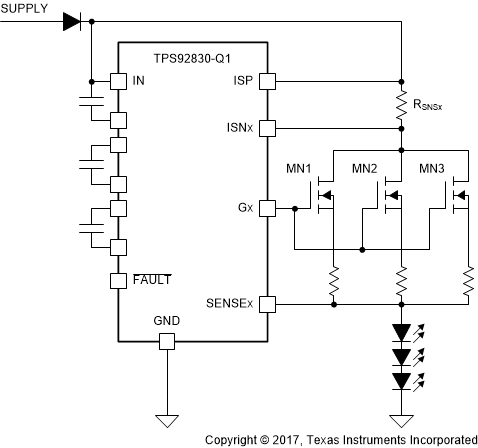ZHCSGY7B October 2017 – January 2018 TPS92830-Q1
PRODUCTION DATA.
- 1 特性
- 2 应用
- 3 说明
- 4 修订历史记录
- 5 说明 (续)
- 6 Pin Configuration and Functions
- 7 Specifications
- 8 Detailed Description
- 9 Application and Implementation
- 10Layout
- 11器件和文档支持
- 12机械、封装和可订购信息
8.3.3.5 Parallel MOSFET Driving
The TPS92830-Q1 device is designed to support parallel N-channel MOSFETs driving within the same channel. To balance heat dissipation, multiple MOSFETs could be paralleled together. A ballast resistor for each MOSFET is recommended to balance current distribution among parallel MOSFETs.
Larger variation on threshold mismatches requires larger ballast resistors. V(TH_MISMATCH) is the threshold for mismatches within the same batch of MOSFETs. I(CH_MISMATCH) is the allowed mismatch current between the parallel channels. Typically, I(CH_MISMATCH) can be set to 10% of full-range current. The ballast resistor value is set as calculated in the following equation.

The ballast resistor typically ranges from hundreds of milliohms to several ohms depending on the channel current and MOSFET threshold-voltage variations.
 Figure 22. Parallel MOSFET Driving
Figure 22. Parallel MOSFET Driving